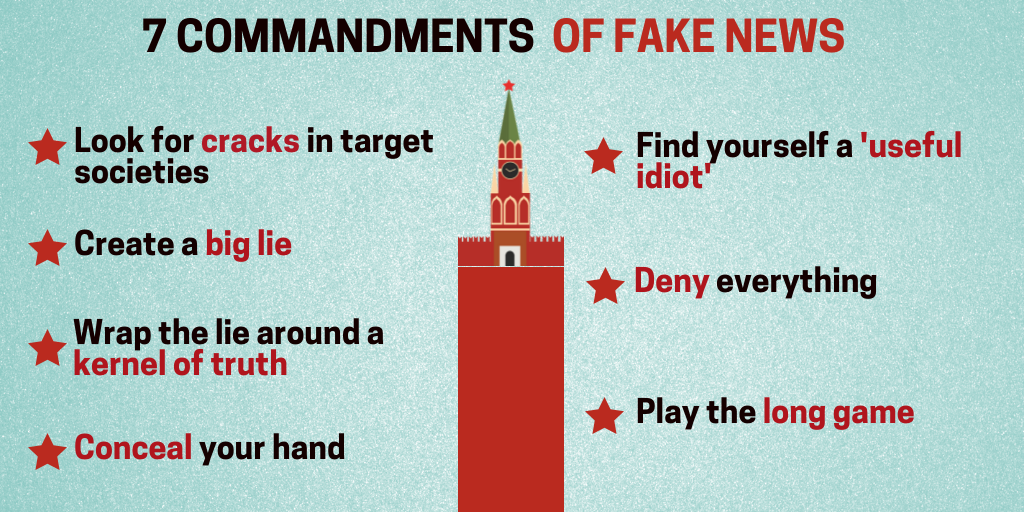A child-trafficking ring run from a pizza-parlor basement by the US Presidential candidate and her team – who would believe this stuff? In the midst of the US Presidential campaign in 2016, quite a few people did. And some even believed it enough to bring a firearm and start shooting inside the said pizza parlor, in a misguided attempt to save child slaves allegedly held there.
In the second episode of the “Operation Infektion” series, the New York Times demonstrates how even the most outrageous lie can be turned into a successful fake news story. All you would have to do is follow the Seven Commandments of Fake News
– a step-by-step guide straight from the Kremlin’s recipe book, on how to cook up the perfect media storm:
- First Commandment: look for cracks in target societies.
- Second Commandment: create a big lie – something so outrageous, no one will believe it is made up.
- Third Commandment: wrap that lie around a kernel of truth – disinformation is most successful when it has a small bit of truth in it.
- Fourth Commandment: conceal your hand – make it seem that the story came from somewhere else.
- Fifth Commandment: find yourself a ‘useful idiot’ – someone who would unwittingly push your message to wider audiences.
- Sixth Commandment: when the truth is uncovered – deny everything.
- Seventh Commandment: play the long game – efforts might not bear fruit for years, but accumulated over a longer period of time they will eventually have a political impact.
EU vs Disinfo has extensively analyzed the strategies and tactics of the Kremlin’s disinformation campaigns. Finding and exploiting differences within pluralistic societies, carefully calibrating disinformation messages to target audiences, wrapping false statements around a kernel of truth, amplifying narratives both through willing and unsuspecting voices
– these are the core features of the Kremlin’s disinformation campaigns. And they are highly effective.
And while the Kremlin’s methods might in many ways be old, its tools are new. While the Soviet KGB had to rely on obscure newspapers, nowadays the Kremlin has a media empire at its disposal.
- Its flagship, TV channel RT (formerly Russia Today) wants global audiences to “question more” 24 hours a day in six languages. It is also fully funded by the Russian government and receives weekly instructions from Kremlin.
- Then there is Sputnik, established by a Presidential decree to “report on state policy of Russia abroad,” with “reporting” so deliberately misleading, that it prompted the President of France Emmanuel Macron to call out Sputnik along with the RT as “agencies of influence and propaganda, lying propaganda – no more, no less.”
- In addition to that, there are ubiquitous online sites in Kremlin’s arsenal, which intentionally conceal their links to Russia. Not least among them – the infamous Internet Research Agency (aka St. Petersburg’s “Troll factory”), which was at the center of Russian attempts to influence the public opinion on social media before the 2016 US Presidential election.
With time-tested methods and ample modern tools, the Kremlin relentlessly pursues the strategy of “divide and rule” – to break alliances, turn individuals, social groups, and countries
against one another and weaken the West in a classic zero-sum game approach.
Read and watch the first part:
New York Times sheds light on decades-old tradition of Kremlin disinformation campaign.
Watch entire series on the NYT website.
Read also:
- How Russia produces conspiracies on bio weapons to befog Skripal case
- Five ways Russia is generating a conspiracy smokescreen around the Skripal poisoning
- Four years on, Russian MH17 disinformation campaign still going strong
- Increased violence in Donbas coincides with spike in anti-Ukrainian aggressive rhetoric on Russian TV
- A guide to Russian propaganda. Part 3: Rapid fire conspiracy theories
- 15-point checklist of Putin regime’s propaganda techniques
- Perfection as a weapon of hybrid warfare






